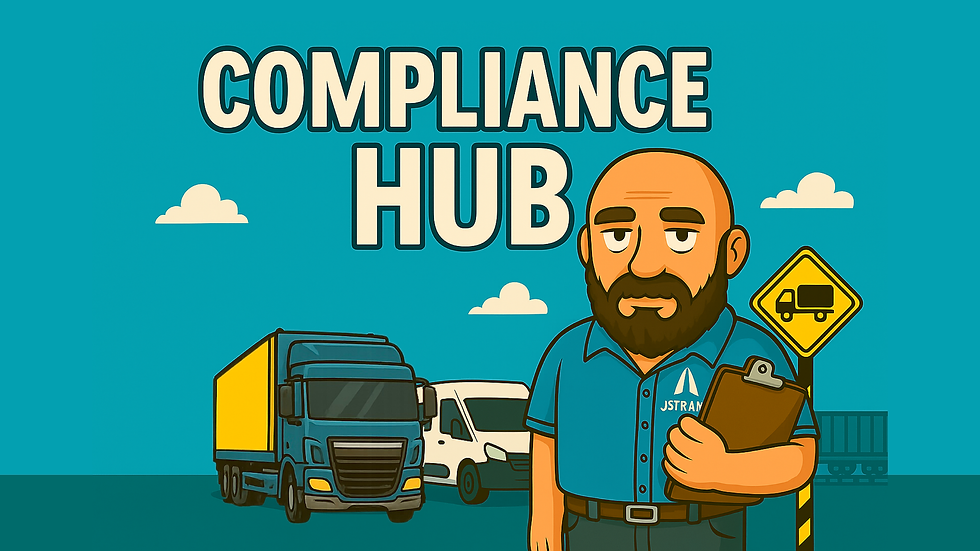How DVSA Target Operators: Understanding the OCRS System
- stuart47304
- Jul 8
- 4 min read

Ever wondered how the DVSA decides which vehicles to stop at the roadside or which operators to inspect?
It’s not just random.
They use a system called OCRS — the Operator Compliance Risk Score — to identify which operators pose the greatest risk to road safety and licence compliance.
In this guide, you’ll learn:
What the OCRS is and how it works
How your score is calculated
Why even Restricted Licence holders should care
What causes your risk to rise
How to improve your score and avoid DVSA attention
What is the OCRS?
The Operator Compliance Risk Score (OCRS) is a tool used by the DVSA to prioritise which transport operators should be:
✅ Targeted for roadside inspections
✅ Subject to further investigations
✅ Called to a maintenance audit or Public Inquiry
It’s a performance monitoring system — and your score reflects how well (or badly) your vehicles and drivers have performed during DVSA checks over the last 3 years.
Does OCRS Apply to Restricted Licence Holders?
Yes — absolutely.
Your licence type doesn’t exempt you. Whether you operate under a Standard or Restricted Licence, OCRS tracks:
Roadworthiness issues
Traffic offences (e.g. driver hours, overloading)
Vehicle test (MOT) history
Inspection results
Prohibitions and fixed penalties
If you’re operating vehicles above 3.5 tonnes, DVSA is watching — even if you only run one lorry.
How the OCRS Works: The Basics
OCRS is made up of two separate scores:
1. Roadworthiness Score
Measures maintenance-related issues like:
Defects found at the roadside
Missed inspections
MOT failures
Incomplete or poorly recorded defect reporting
2. Traffic Score
Measures issues like:
Driver hours infringements
Tachograph abuse or missing data
Overloading
Speeding
Use of mobile phones while driving
Each category is scored out of 100 and weighted based on severity.
The Colour Bands: What Do They Mean?
Operators are placed into one of four risk bands:
Colour | Risk Level | What It Means |
Green | Low | Compliant and unlikely to be stopped |
Amber | Medium | Some issues, may be targeted |
Red | High | Likely to be stopped or inspected |
Grey | Unknown | No sufficient data to score |
Most new operators start off in grey, and stay there until enough activity is recorded.
How Points Are Scored
Every incident (defect, offence, failure) generates penalty points based on how serious it is.
Points are:
Higher for dangerous defects (e.g. brakes, steering)
Lower for minor infringements (e.g. late break or driver card expired)
Weighted by how recent the incident is — more recent = more impact
Scaled by fleet size (e.g. one defect in a 1-vehicle fleet carries more weight)
The points decay over time, typically after 1 to 3 years.
Important: If you’ve never been stopped, that doesn’t guarantee you’re safe. It just means there’s no data — which can be risky in itself.
How to Check Your OCRS
As of recent DVSA updates, you can access your own OCRS via:
👉 The DVSA Vehicle Operator Licensing system
👉 Ask for it via your VOL account or contact DVSA directly
You’ll need to log in as the licence holder or transport contact.
What Makes Your OCRS Worse?
Action or Issue | Impact |
S-marked prohibition at roadside | Very high negative impact |
Missing scheduled safety inspections | High |
Tachograph misuse | High |
MOT failures | Moderate to high |
Overloading | Moderate |
Failure to carry out daily walkarounds | Moderate |
Repeated minor defects (e.g. lights, tyres) | Adds up over time |
These points push you toward amber or red, increasing the chance of:
Roadside stops
DVSA inspections at your premises
Being flagged for enforcement
A potential Public Inquiry
What Improves Your OCRS?
Keeping a clean MOT pass history
Regular, well-documented maintenance
Fully compliant driver checks and training
Addressing defects and infringements quickly
Using digital systems or logs to track compliance
DVSA roadside stops that find no issues (yes, these help!)
Should You Be Worried If You’re in the Grey Band?
Being in the grey zone means:
You haven’t had enough roadside interactions for DVSA to assess risk
You might be flying under the radar — for now
But one prohibition could push you straight into amber or red
That’s why even Restricted Operators should manage as if they’re being scored.
How to Stay Green: Practical Steps
✅ Schedule and track PMIs using a calendar or digital planner
✅ Conduct and store walkaround checks daily
✅ Rectify defects with written evidence
✅ Check MOT dates and fix issues proactively
✅ Download and review tachograph data (if applicable)
✅ Train drivers on working hours and reporting
✅ Review your compliance files monthly
What Happens If You’re Red?
You can expect:
Increased chance of roadside inspections
DVSA requesting documentation
Greater scrutiny at MOT
Higher risk of Public Inquiry
But all is not lost — you can:
Improve your practices
Address historic issues
Let time pass without new penalties
Request a voluntary DVSA audit to demonstrate improvement
Conclusion
OCRS might sound like a behind-the-scenes tool — but it’s one of the main ways DVSA decides who to target.
Whether you’re running a single 7.5-tonne vehicle or a growing fleet, your OCRS is a reflection of how seriously you take road safety and compliance.
You don’t need to obsess over the numbers — but you do need systems that show you’re in control. That’s the difference between staying green and getting caught out.
Next in the series:👉 What Happens During a DVSA Roadside Check?
